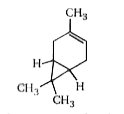How many isomeric structural alkene on catalytic hydrogenation gives 3-Methyl hexane.
3
4
5
6
The correct Answer is:D
To determine how many isomeric structural alkenes can yield 3-methylhexane upon catalytic hydrogenation, we can follow these steps:
Step 1: Understand the structure of 3-methylhexane
3-methylhexane has a total of 6 carbon atoms in the main chain (hexane) and a methyl group (–CH₃) attached to the third carbon. The structural formula can be represented as follows:
CH₃∣CH₃−CH−CH₂−CH₂−CH₃
Step 2: Identify the possible alkenes
To find the alkenes that can yield 3-methylhexane upon hydrogenation, we need to consider the positions of the double bonds in the carbon chain.
Step 3: Draw the alkenes
1. Alkene 1: Place a double bond between C1 and C2.
- Structure: CH₂=CH-CH(CH₃)-CH₂-CH₂-CH₃
2. Alkene 2: Place a double bond between C2 and C3.
- Structure: CH₃-CH=CH(CH₃)-CH₂-CH₂-CH₃
3. Alkene 3: Place a double bond between C3 and C4.
- Structure: CH₃-CH₂-CH=CH-CH₂-CH₃
4. Alkene 4: Place a double bond between C4 and C5.
- Structure: CH₃-CH₂-CH₂-CH=CH-CH₃
5. Alkene 5: Place a double bond between C1 and C6 (terminal alkene).
- Structure: CH₂=CH-CH₂-CH₂-CH(CH₃)-CH₃
Step 4: Count the isomers
After identifying the alkenes, we find that there are a total of 5 distinct isomeric structural alkenes that can be hydrogenated to form 3-methylhexane.
Final Answer
Thus, the total number of isomeric structural alkenes that give 3-methylhexane upon catalytic hydrogenation is 5.
---
3-methylhexane has a total of 6 carbon atoms in the main chain (hexane) and a methyl group (–CH₃) attached to the third carbon. The structural formula can be represented as follows:
To find the alkenes that can yield 3-methylhexane upon hydrogenation, we need to consider the positions of the double bonds in the carbon chain.
1. Alkene 1: Place a double bond between C1 and C2.
- Structure: CH₂=CH-CH(CH₃)-CH₂-CH₂-CH₃
- Structure: CH₃-CH=CH(CH₃)-CH₂-CH₂-CH₃
- Structure: CH₃-CH₂-CH=CH-CH₂-CH₃
- Structure: CH₃-CH₂-CH₂-CH=CH-CH₃
- Structure: CH₂=CH-CH₂-CH₂-CH(CH₃)-CH₃
After identifying the alkenes, we find that there are a total of 5 distinct isomeric structural alkenes that can be hydrogenated to form 3-methylhexane.
Thus, the total number of isomeric structural alkenes that give 3-methylhexane upon catalytic hydrogenation is 5.
Topper's Solved these Questions
- STRUCTURAL IDENTIFICATIONBook:RESONANCE ENGLISHChapter:STRUCTURAL IDENTIFICATIONExercise:Advanced level Problems (Part-II)
Explore 21 Videos
- STRUCTURAL IDENTIFICATIONBook:RESONANCE ENGLISHChapter:STRUCTURAL IDENTIFICATIONExercise:Advanced level Problems (Part-III)
Explore 12 Videos
- STRUCTURAL IDENTIFICATIONBook:RESONANCE ENGLISHChapter:STRUCTURAL IDENTIFICATIONExercise:Exercise-3 Jee (Advanced) (Part-II)
Explore 15 Videos
- STEREOISOMERISMBook:RESONANCE ENGLISHChapter:STEREOISOMERISMExercise:EXERCISE (PART III : PRACTICE TEST-2 (IIT-JEE (ADVANCED PATTERN))
Explore 23 Videos
- SURFACE CHEMISTRYBook:RESONANCE ENGLISHChapter:SURFACE CHEMISTRYExercise:Section - 5
Explore 1 Video
Similar Questions
Knowledge Check
How many alkene on catalytic hydrogenation given isopentane as a product ?
A2B3C4D5Which alkyne will give 3-ethylhexane on catalytic hydrogenation ?
A B
B C
C DAll of these
DAll of theseWhich of the following alkene on catalytic hydrogenation given cis and trans-isomer ?
A B
B C
C Dall of these
Dall of these
How many alkene on catalytic hydrogenation given isopentane as a product?
View SolutionHow many isomeric alkyne of hydrogenation gives 3,3 - Dimethylhexane.
View SolutionWrite structures of all the alkenes which on hydrogenation give 2-methylbutane.
View SolutionHow many alkenes on catalytic hydrogenation give isopentane as a product (consider only structural isomers) ?
View SolutionWhich alkyne will give 3-ethylhexane on catalytic hydrogenation?
View Solution